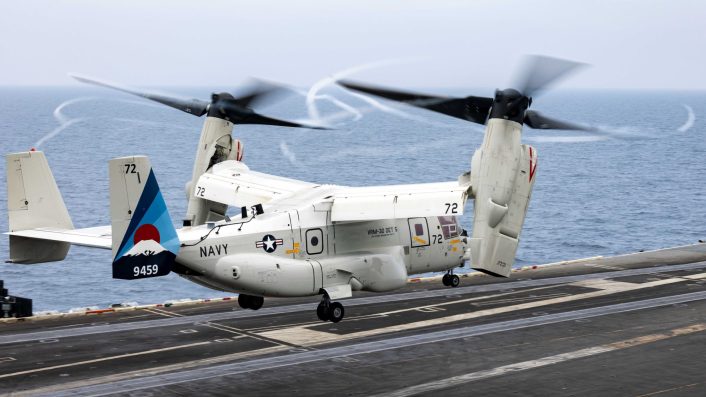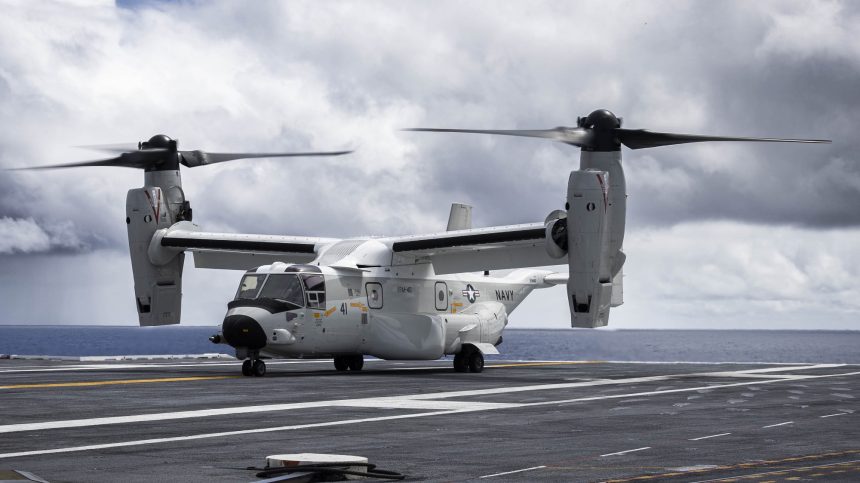The Fleet Readiness Center Southwest reduced the required maintenance time by more than 24%, increasing readiness without sacrificing safety standards.
In a “significant milestone,” the Fleet Readiness Center Southwest’s (FRCSW) Props team reduced the Planned Maintenance Interval (PMI) cycle for the CMV-22 Osprey tiltrotor “from 264 days to under 200 days – a reduction of more than 24%.” A press release from the Naval Air Systems Command (NAVAIR) said the shortened “maintenance timeline directly supports naval aviation readiness goals” pertaining to the operation of the Osprey.
“Fleet Readiness Center Southwest’s (FRCSW) mission is to maintain the operational readiness of advanced aircraft like the CMV-22 Osprey,” explained the press release. “The command provides crucial support to the men and women of the Navy and Marine Corps allowing them to deliver the lethality necessary to defeat any foe.”
The CMV-22B is the newest Osprey variant, which entered service in June 2020 on the West Coast and Apr. 2024 on the East Coast, and is specifically modified for the Navy’s needs. The Marine Corps MV-22B Osprey has been flying operationally since 2007, while the Air Force CV-22 variant has been in operational use since 2009.
En esta foto, se aprecian perfectamente los “mofletes” que diferencian a un CMV-22B de los otros #Osprey (MV y CV), por cierto que la Fleet Readiness Center Southwest’s (FRCSW) ha reducido el periodo de mantenimiento programado (PMI) un 24%#CMV22B pic.twitter.com/nJFk1mmyHg
— Roberto_yeager (@Roberto_yeager) June 2, 2025
Rapid maintenance of complex aircraft
Calling the CMV-22 Osprey “a complex tiltrotor aircraft combining the vertical takeoff and landing capabilities of a helicopter with the speed and range of a fixed wing plane,” the Navy explained that its PMI cycle comprises “extensive inspection, repair, testing and refurbishment of critical systems including engines, rotors, avionics and airframe components.”
The team was able to obtain a shortened maintenance cycle thanks to a new “workflow analysis and process optimization efforts” that were included in the planning. “The team managers laid out all phases/processes/etc. required and worked directly with the artisans performing the work to develop a new way to sequence events,” explained the release.
The FRCSW team then “identified and eliminated inefficiencies in multiple maintenance phases, setting the stage to achieve this milestone.” This deliberate and systematic approach “enabled the team to significantly shorten the PMI cycle without sacrificing the high standards required for safety and quality.”
The team also worked with “outside entities to ensure any delays outside the commands purview,” would not affect the team’s timeline. This was defined as a “key factor” in avoiding “delays that had previously extended maintenance timelines.”

In Aug. 2021, the Fleet Readiness Center (FRCE) at MCAS (Marine Corps Air Station) Cherry Point, North Carolina, started the Planned Maintenance Interval 1 (PMI 1) of its first CMV-22B Osprey. Until then, the FRCE detachments at MCAS New River, North Carolina, and the Air Force’s Hurlburt Field in Florida only serviced the Osprey’s MV-22B and CV-22B variants. Cherry Point’s team looked at the CMV-22B maintenance with “fresh eyes” as if it were a new capability, rather than an extension of the familiar workload with “pre-existing expectations.”
That first CMV-22B also had “very low” flight hours and was essentially in a new condition. In fact, it was the first operational CMV-22B Osprey delivered to the U.S. Navy on Jun. 22, 2020, assigned to Fleet Logistics Multi-Mission Squadron 30 (VRM-30) “Titans” at Naval Air Station North Island. VRM-30 was also the first CMV-22B unit, established in 2018 at Naval Base Coronado.
Increased availability, reduced downtime
Delivering the CMV-22B Osprey in 200 days instead of 264 days allows “more aircraft available for training, deployment and operational readiness,” said NAVAIR. “The CMV-22 plays a vital role in carrier onboard delivery and logistics support, making its availability essential for sustained naval operations,” the release added.
RUDY
実は初撮影だったCMV
尾翼のマーキングがグレイハウンドから受け継がれてるのが嬉しい限り😌
US Navy / VRM-30
Bell Boeing CMV-22B(169452)
at Kadena Airbase
-2024.06.20- pic.twitter.com/7TYSkekjJU
— NORAN (@the_NORAN_) June 25, 2024
This achievement reflects FRCSW’s commitment to providing the Navy and Marine Corps with the mission capable aircraft, achieved by “accelerating maintenance cycles.” FRCSW will continue to innovate and refine maintenance processes for the CMV-22 and other fleet assets.
The Navy has been experimenting with smaller Vertical Take-Off Landing (VTOL) drones to ferry light to medium weight cargo between ships of a fleet, and spare operational, fuel and logistical costs, as well as airframe life, of the larger CMV-22Bs and MH-60R helicopters that are commonly used for such goods. The goal remains clear: sustain and improve aircraft readiness so that naval aviation forces can remain agile, effective and prepared for the challenges of today and tomorrow.
U.S. Navy’s CMV-22B ‘CODspreys’
In Mar. 2025, NAVAIR Patuxent River, Maryland, awarded Bell-Boeing’s Joint Program Office a $590 million contract, to be executed by Jan. 2028, for five more CMV-22B Ospreys. While the Program of Record has 48 CMV-22 projected, the U.S. Navy currently plans to only procure 44 aircraft, according to NAVAIR.
US Navy CMV-22B Ospreys are secured in hangar at Naval Air Station North Island, California, Aug. 19, in preparation for expected inclement weather. pic.twitter.com/jN3ODdMTN5
— Ryan Chan 陳家翹 (@ryankakiuchan) August 19, 2023
The Navy’s “CODsprey,” as they are nicknamed, standing for Carrier Onboard Delivery Osprey, are different from the MV-22Bs, as they have fuel tank extensions to the forward portion of the sponsons on both sides of the fuselage. This offers the extra range to support the Navy’s COD roles and increased mission flexibility over the legacy C-2A Greyhound.
US Navy sailors prepare to launch three CMV-22B Ospreys from aircraft carrier USS Theodore Roosevelt (CVN-71) on May 9. USS Theodore Roosevelt is conducting carrier qualifications in Pacific Ocean ahead of an upcoming deployment workup cycle. pic.twitter.com/pLNgNitAos
— Ryan Chan 陳家翹 (@ryankakiuchan) May 10, 2023
The shortened downtime and increased maintenance turnaround speed of the U.S. Navy’s CMV-22B Osprey also comes amid the impending retirement of the C-2 Greyhounds. That older aircraft’s operations had to be surged following the military-wide and global three-month grounding of all Ospreys in response to the crash of an AFSOC CV-22B off the coast of Japan on Nov. 29, 2023 that killed eight airmen.









